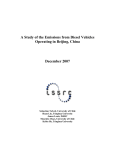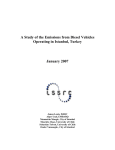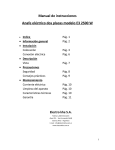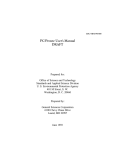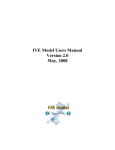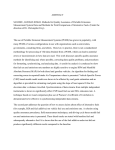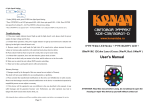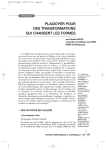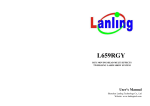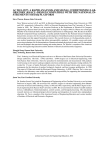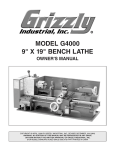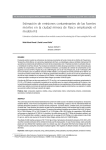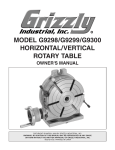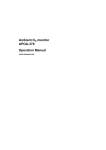Download Xi`an Diesel Study Report - International Sustainable Systems
Transcript
A Study of the Emissions from Diesel Vehicles Operating in Xi’an, China June 2008 Sebastian Tolvett, ISSRC Huan Liu, Tsinghua University Yingzhi Zhang, Tsinghua University James Lents, ISSRC Mauricio Osses, University of Chile Kebin He, Tsinghua University 1 Table of Contents I. INTRODUCTION ................................................................................................................................................ 1 II. TESTING PROCEDURE................................................................................................................................... 2 III. MEASUREMENT ERROR.............................................................................................................................. 5 IV. OVERALL RESULTS ...................................................................................................................................... 6 V. VEHICLE EMISSIONS UNDER DIFFERENT DRIVING CONDITIONS .............................................. 14 VI. EMISSION COMPARISONS WITH THE IVE MODEL .......................................................................... 16 VII. CONCLUSIONS............................................................................................................................................. 18 List of Tables TABLE 1: DIESEL VEHICLES TESTED DURING THE STUDY ............................................................................................. 1 TABLE 2: ESTIMATION OF EXPECTED VARIATION IN TEST DATA FOR REPEATED DRIVING CYCLES .............................. 5 TABLE 3: EMISSION MEASUREMENT RESULTS FOR THE TESTED XI’AN DIESEL FLEET.................................................. 6 TABLE 4: EMISSION MEASUREMENT RESULTS FOR THE TESTED XI’AN DIESEL FLEET (CONTINUED) ........................... 7 TABLE 5: POTENTIAL ADJUSTMENT VALUES TO BE USED IN IVE MODEL .................................................................. 17 TABLE 6: RECOMMENDED ADJUSTMENT VALUES FOR USE IN THE IVE MODEL .......................................................... 18 TABLE 7: EMISSIONS RESULTS FOR AN AVERAGE FLEET IN SEVERAL CITIES ................................................................ 18 List of Figures FIGURE 1: ISSRC FIELD DILUTION DEVICE ................................................................................................................... 3 FIGURE 2: FLOW DIAGRAM FOR THE OVERALL EMISSIONS TESTING SYSTEM ............................................................... 3 FIGURE 3: EXTERIOR OF A TRUCK OUTFITTED FOR EMISSIONS TESTING ....................................................................... 4 FIGURE 4: WATER BARRELS FOR EMISSIONS TESTING .................................................................................................. 4 FIGURE 5: NUMBER OF VEHICLES BY MODEL YEARS FOR THE TESTED LIGHT DUTY TRUCKS (G/KM)........................... 8 FIGURE 6: EMISSIONS AVERAGED OVER SELECTED MODEL YEARS FOR LIGHT DUTY (G/KM) ....................................... 8 FIGURE 7: VEHICLES DISTRIBUTION ACCORDING TO EMISSIONS STANDARD ................................................................. 9 FIGURE 8: FTP NORMALIZED EMISSIONS AVERAGED OVER EMISSIONS STANDARDS OVERALL ................................. 10 FIGURE 9: VEHICLES DISTRIBUTION ACCORDING TO WEIGHT...................................................................................... 11 FIGURE 10: FTP NORMALIZED EMISSIONS AVERAGED OVER VEHICLE WEIGHT ......................................................... 11 FIGURE 11: VEHICLES DISTRIBUTION ACCORDING TO MILEAGE .................................................................................. 12 FIGURE 12: FTP NORMALIZED EMISSIONS AVERAGED OVER VEHICLE MILEAGE ....................................................... 13 FIGURE 13: FRACTION OF DRIVING IN VARIOUS BINS .................................................................................................. 14 FIGURE 14: CO2 EMISSIONS FROM LIGHT DUTY VEHICLES BY IVE BIN ..................................................................... 14 FIGURE 15: NOX EMISSIONS BY IVE BIN .................................................................................................................... 15 FIGURE 16: PM EMISSIONS BY IVE BIN ....................................................................................................................... 15 FIGURE 17: COMPARISON OF MEASURED EMISSION RATES WITH IVE PREDICTED EMISSION RATES .......................... 17 FIGURE 18: COMPARISON OF MEASURED EMISSION IN SEVERAL CITIES NORMALIZED TO THE FTP(LA4) CYCLE AND GROUPED TO SIMILAR SIZE DISTRIBUTIONS ....................................................................................................... 19 2 I. Introduction From April 4 to May 9, 2008 a series of 40 diesel vehicles were tested in Xi’an China. All of these vehicles were classified as light-heavy-duty vehicles. The tests were carried out in Xi’an at a laboratory in Shaanxi University of Science and Technology. Table 1indicates the vehicles that were tested. Table 1: Diesel Vehicles Tested During the Study Test Number Vehicle Type Model Emission Standard Year Odometer (km) Size (kg) 1 Light Truck JIEFANG Euro 2 2005 47485 2480 2 Light Truck JINBEI Euro 2 2007 24000 2480 3 Light Truck FUTIAN Euro 1 2003 129578 2430 4 Light Truck KAIMA Euro 2 2007 20282 2790 5 Light Truck LANLING Euro 1 2001 230000 3100 6 Light Truck JIANGHUAI Euro 2 2008 7617 2495 7 Light Truck JINBEI Euro 2 2007 45678 2360 8 Light Truck YUEJIN Euro 0 1999 264945 2450 9 Light Truck YUEJIN Euro 2 2005 107805 3470 10 Light Truck YUEJIN Euro 2 2007 8184 2680 12 Light Truck JINBEI Euro 2 2007 32863 2340 11 Light Truck YUEJIN Euro 2 2005 65731 2165 13 Light Truck YUEJIN Euro 2 2007 9776 3710 14 Light Truck JINBEI Euro 1 2002 163468 1950 15 Light Truck JIANGHUAI Euro 1 2001 234500 4000 16 Light Truck YUEJIN Euro 2 2007 18546 2680 17 Light Truck JINBEI Euro 2 2007 25725 2500 18 Light Truck JIEFANG Euro 2 2006 75000 3240 19 Light Truck YUEJIN Euro 2 2005 71951 2290 20 Light Truck SHI DAI Euro 2 2007 35000 2070 21 Light Truck JINBEI Euro 1 2002 156135 3890 22 Light Truck JINBEI Euro 2 2008 3654 2340 23 Light Truck JINBEI Euro 2 2008 4753 2810 24 Light Truck FUTIAN Euro 1 2002 116695 2200 25 Light Truck QINGQI Euro 1 2002 172691 2450 26 Light Truck JINBEI Euro 2 2008 5765 4295 27 Light Truck JIANGHUAI Euro 2 2007 40077 3295 28 Light Truck SHIHUA Euro 2 2005 62524 2360 29 Light Truck FUTIAN Euro 1 2003 167155 4000 30 Light Truck SHIDAI Euro 2 2007 18833 2690 31 Light Truck YUEJIN Euro 2 2005 115075 2170 32 Light Truck YUEJIN Euro 2 2008 1623 2080 33 Light Truck YUEJIN Euro 1 2004 91743 3815 34 Light Truck JIANGHUAI Euro 1 2001 211500 5750 35 Light Truck JIANGHUAI Euro 2 2006 43968 3295 36 Light Truck DONGFENG Euro 2 2006 53887 4200 37 Light Truck DONGFENG Euro 2 2004 73125 4420 38 Light Truck DONGFENG Euro 1 2002 206809 4170 39 Light Truck YUEJIN Euro 2 2007 24525 2895 40 Light Truck Euro 1 2003 87397 4661 1 This study was a joint effort of the Tsinghua University and the International Sustainable Systems Research Center (ISSRC). II. Testing Procedure Vehicles were brought to the test site by drivers supplied by the owners of the vehicles for test equipment installation. These vehicles were warmed up at the time of the testing. Once the emissions testing equipment was installed, the vehicles were driven over a prescribed driving circuit by the original vehicle drivers. The driving route was designed so that the vehicles would be operated over as wide a range of operating conditions as could be achieved within the city limits of Xi’an. The driving circuit required from 30 to 40 minutes to complete depending upon the traffic situation and included a moderate hill that the vehicles drove over. For emission measurement purposes, a Semtech Sensor D gas emissions testing unit was used to measure the emissions of CO, CO2, total Hydrocarbons (THC), NOx, and NO2. The Sensor D unit uses infrared absorption technology to measure CO and CO2 , ultraviolet absorption technology to measure NOx and NO2, and a flame ionization detector to measure total hydrocarbon emissions. The Sensor D testing unit is an integrated emissions testing device designed to be used in on-road testing programs. The Sensor D measures emission concentrations and must be provided with exhaust flow rates and ambient temperatures and pressures in order to determine mass emission rates. The Sensor D is equipped with a temperature/pressure sensor. A Semtech manufactured 4 inch (10 cm) exhaust flow measurement device was used to measure the exhaust flow rate from the vehicles. This device uses standard dynamic and static pressure measurement techniques to calculate exhaust flow. The Sensor D was also equipped with a GPS device to measure location and speed. All data were collected at one second intervals. For further information on the Sensor D test unit and the Semtech exhaust flow device please go to www.sensors-inc.com . The Sensor D test unit was zeroed and spanned at each set of test cycles. The unit was found to be very stable from day to day with the zero and span holding within 1% of the calibration gases values from day to day. Particulates were measured on a second by second basis using a Dekati DMM testing unit. This unit uses a particle charging process and six stage impactor setup to determine particle mass. The DMM measures particle concentration. The exhaust flow rates collected by the Sensor D unit must be used with the Dekati measurements to determine particulate mass flow rates. The DMM measures particles in the 0 to 1.5 micron range, which is the size range where virtually all diesel particulates reside. The DMM has been found to produce results comparable to the reference particulate sampling methods for diesel particulates; although, it was found to produce readings about 30% high in one published study. Dekati experts believe that this is due to the fact that the Dekati measurement process can measure volatile particulate matter that is lost in the case of filter based particulate sampling devices. For further information on the DMM, please see www.dekati.com. The DMM was zeroed at the beginning of each testing cycle. The charging and impactor units become covered with particulates and must be cleaned after each 2-3 hours of testing to keep the unit operating properly. 2 The DMM can not handle the mass concentrations found in uncontrolled diesel exhaust. Thus, the diesel exhaust must be diluted at a controlled rate in order to use the DMM. A field dilution device was developed by ISSRC to use in on-road emissions testing with the DMM. Figure 1 illustrates the design of the ISSRC field dilution unit. Figure 1: ISSRC Field Dilution Device The exhaust flow in the dilution device is measured using a Dwyer differential pressure transducer, which is accurate to 0.25% of full scale. The differential pressure gauge is used to measure the pressure difference between P2 and P3 shown in Figure 1. A micro-filter produces particle free air to be diluted with the exhaust sample. The exhaust sample and dilution air are heated to 110 degrees C to avoid water and organic condensation. The dilution level reaches values from 20 to 1 to 30 to 1 depending on the vehicle tested and the exhaust flow rate. Figure 2 presents a flow diagram for the overall emissions testing system. The data collected by Figure 2: Flow Diagram for the Overall Emissions Testing System the flow measurement device and the Sensor D are recorded to a flash card on the Sensor D unit. The Dekati information is recorded to a laptop computer that is connected to the Dekati by a serial cable. 3 Figure 3 and Figure 4 show the exterior of a truck outfitted for testing. Figure 3: Exterior of a Truck Outfitted for Emissions Testing Figure 4: Water Barrels for Emissions Testing 4 In order to simulate a loaded truck, 200 Kilograms of water in barrels were placed on the truck according to the carrying capacity of the truck. Depending upon the size of the vehicles, barrels were loaded to simulate 50% of the total load capacity to produce consistent measurements. Appendix A contains a description of the overall testing procedure and data processing steps. III. Measurement Error No measurement process is free from measurement and operating error. Referring to Figure 2, there is the potential for measurement error in the flow measurement process, the dilution rate measurement, the gas concentrations measurement. Table 2 outlines potential error assuming that each process can be held to produce only 2% error to help understand the expected variations in results from the repeated testing. Table 2: Estimation of Expected Variation in Test Data for Repeated Driving Cycles Impact on Gaseous Measurements 2% --2% 4% Measurement Process Exhaust Volume Flow Measurement Dilution Measurement Emissions Concentration Measurement Total Potential Variation Impact on Particle Measurements 2% 2% 2% 6% To further complicate the process, data is collected on normal city streets which results in different driving patterns from test to test. Daily variations in traffic flow have a major impact on how the vehicles can be operated. Thus, emissions can vary considerably from test to test even using the same vehicle. To correct for this variation, the data is divided into different power demand categories. 60 power demand categories are used for this purpose. These categories are typically referred to as Power Bins and are numbered from 0 to 59. The amount of emissions that occurs when the vehicle is operated in each of the 60 Power Bins is determined.1 This bin emission rate is multiplied by the driving distribution that would have occurred had the vehicle driven an FTP driving cycle to produce a standardized estimate of emissions that would have resulted if the vehicle had been operated on an FTP cycle. This approach was found in an already published study in Brazil to produce estimates of emissions on the actual driving cycle within 6%. While this is good in many respects, it must be added to measurement uncertainty indicated in Table 2, which results in a potential emissions error of 10-12% overall. The error discussed in the previous paragraphs should be random and thus should average out to some degree over multiple tests. Finally, the number of vehicles that can be tested in a 2 week period is limited. This limited testing further decreases the certainty of how well the tested fleet actually represents the actual urban fleet. Based on ISSRC data collected in similar gasoline emissions studies, the collection 1 A vehicle will typically not operate in all of the defined Power Bins during a given driving test. Since this data is only used to calculate emissions projected for an FTP cycle, it is only important to have values for the bins that occur in the FTP cycle. This usually occurs. In the few cases were a FTP bin is missing, then the data is interpolated to fill in values. 5 of data from a fleet of randomly selected gasoline fueled vehicles resulted in 90% confidence interval of plus or minus 20%. When all potential errors are combined, it should be anticipated that this study will produce results which are to a 90% probability to within 20-30% of the actual emissions produced by the local fleet. While this potential error is larger than preferred, it is still better than using emission estimates derived from studies in the U.S. and Europe. In the long run, more emissions tests are required in order to reduce the mobile source inventory uncertainty to the more preferred 10% range. IV. Overall Results Table 3 and Table 4 present the average emissions measured for the various vehicles tested in the program. They are listed in the order tested. An average value and 90% confidence limits are also included at the end of Table 4. The 90% confidence interval in Table 4 indicates the range of emissions for which there is a 90% probability that the true mean emission rate of the fleet would exist if the tested vehicles were randomly selected from the Xi’an fleet. The vehicles tested should be somewhat representative of the Xi’an fleet, thus, the measured values are likely within 20-25% of the true mean of the Xi’an fleet. It should be noted that any zero emissions shown in Tables 3 or 4 indicates that emissions measured for the vehicles were below the detection limits of the equipment. This only occurs in the case of CO and THC due to the fact that diesel vehicles run with high amounts of air compared to the fuel and a well running engine can have low CO and THC. Table 3: Emission Measurement Results for the Tested Xi’an Diesel Fleet Test Vehicle Type Year Number 1 Light Truck 2 Light Truck 3 Light Truck 4 Light Truck 5 Light Truck 6 Light Truck 7 Light Truck 8 Light Truck 9 Light Truck 10 Light Truck 11 Light Truck 12 Light Truck 13 Light Truck 14 Light Truck 15 Light Truck 16 Light Truck 17 Light Truck 18 Light Truck 19 Light Truck 20 Light Truck Measured Emissions (grams/kilometer) Std FTP Normalized Emissions (grams/kilometer CO2 NOx PM CO THC CO2 NOx PM CO THC 2005 Euro 2 2007 Euro 2 341 5.62 0.325 10.93 1.93 401 7.74 0.392 13.25 2.16 283 3.42 0.071 1.60 1.19 336 4.70 0.088 1.97 1.38 2003 Euro 1 2007 Euro 2 253 2.83 0.245 3.26 1.59 294 3.87 0.294 3.92 1.77 430 10.83 0.066 1.96 1.98 396 13.56 0.063 1.86 1.56 2001 Euro 1 2008 Euro 2 284 3.23 0.359 3.63 1.48 350 4.64 0.458 4.64 1.79 275 4.25 0.148 5.63 1.38 328 5.50 0.179 6.88 1.64 2007 Euro 2 1999 Euro 0 394 5.99 0.294 12.35 2.33 360 6.97 0.251 10.59 1.87 298 2.99 0.496 14.63 2.28 296 3.83 0.504 14.99 2.02 2005 Euro 2 2007 Euro 2 314 4.43 0.116 3.15 1.34 381 5.90 0.146 3.96 1.63 246 4.51 0.090 1.31 1.29 281 6.11 0.106 1.54 1.40 2007 Euro 2 2005 Euro 2 266 5.16 0.058 1.39 1.26 305 6.74 0.065 1.56 1.39 229 4.54 0.085 1.32 1.56 226 5.87 0.080 1.24 1.33 2007 Euro 2 2002 Euro 1 329 4.98 0.101 1.68 1.78 381 6.56 0.121 2.00 2.00 342 7.04 0.172 7.83 1.32 380 8.56 0.198 8.95 1.44 2001 Euro 1 2007 Euro 2 305 5.79 0.080 3.60 2.15 371 7.82 0.098 4.41 2.60 265 4.52 0.209 2.66 1.27 309 5.66 0.246 3.13 1.47 2007 Euro 2 2006 Euro 2 288 4.03 0.122 4.28 1.34 332 5.27 0.146 5.11 1.51 223 3.91 0.042 1.02 0.63 269 5.17 0.052 1.26 0.75 2005 Euro 2 2007 Euro 2 319 10.04 0.075 1.69 1.07 362 12.50 0.086 1.91 1.18 283 5.67 0.369 7.16 1.45 338 7.64 0.454 8.82 1.68 6 21 Light Truck 2002 Euro 1 351 8.78 0.245 13.60 1.58 403 10.09 0.281 15.79 1.80 Table 4: Emission Measurement Results for the Tested Xi’an Diesel Fleet (continued) Test Vehicle Type Year Number CO2 Measured Emissions (grams/kilometer) NOx PM CO THC CO2 Std FTP Normalized Emissions (grams/kilometer NOx PM CO THC 22 Light Truck 2008 Euro 2 301 3.20 0.161 2.36 0.69 353 4.04 0.193 2.86 0.80 23 Light Truck 2008 Euro 2 288 7.63 0.047 1.99 1.07 361 10.49 0.061 2.57 1.33 24 Light Truck 2002 Euro 1 282 3.52 0.673 2.43 1.74 344 4.79 0.846 3.06 2.13 25 Light Truck 2002 Euro 1 351 3.55 0.180 6.75 2.11 346 4.18 0.182 6.83 1.93 26 Light Truck 2008 Euro 2 336 5.63 0.173 2.15 1.45 425 7.81 0.216 2.70 1.79 27 Light Truck 2007 Euro 2 444 4.60 0.156 4.01 1.68 482 5.52 0.174 4.48 1.79 28 Light Truck 2005 Euro 2 353 9.00 0.076 1.95 1.19 419 12.28 0.093 2.37 1.37 29 Light Truck 2003 Euro 1 295 5.94 0.206 7.73 1.76 333 7.73 0.233 8.74 1.91 30 Light Truck 2007 Euro 2 269 2.90 0.266 4.45 1.30 306 3.82 0.312 5.20 1.43 31 Light Truck 2005 Euro 2 251 4.24 0.103 1.86 1.37 282 5.32 0.119 2.16 1.54 32 Light Truck 2008 Euro 2 294 5.06 0.011 1.46 1.22 368 6.51 0.014 1.77 1.55 33 Light Truck 2004 Euro 1 237 5.52 0.001 3.26 1.26 305 7.55 0.001 4.24 1.67 34 Light Truck 2001 Euro 1 287 4.94 0.160 4.14 1.71 332 5.87 0.155 4.03 1.98 35 Light Truck 2006 Euro 2 366 6.77 0.107 3.41 1.60 380 7.99 0.115 3.61 1.58 36 Light Truck 2006 Euro 2 328 7.76 0.082 1.12 0.52 397 10.07 0.101 1.39 0.62 37 Light Truck 2004 Euro 1 357 5.63 0.111 1.07 0.53 418 7.01 0.132 1.29 0.62 38 Light Truck 2002 Euro 2 339 5.89 0.116 1.29 0.43 417 7.64 0.148 1.63 0.55 39 Light Truck 2007 Euro 2 237 2.90 0.081 0.54 0.97 281 4.00 0.099 0.65 1.12 CO2 NOx PM CO THC CO2 NOx PM CO THC Average of Tests 305.92 5.31 0.17 4.02 1.40 349.95 6.85 0.19 4.55 1.54 90% Confidence Interval 4% 10% 21% 24% 9% 4% 9% 22% 22% 8% Emissions according to Model Year Figure 5 shows the Model Year distribution of the sampled vehicles in this study. There were 4 (10%) of the vehicles in the range of years 1999-2002, 9 (23%) were in the 2002-2005 range and 26 (67%) were in the 2005-2008 year range. Figure 6 shows the CO, HC, NOx, PM and CO2 emissions from the Light Duty Trucks and emissions for three groupings of model years, as can be seen in Figure 5. There is a little overall relation between emissions and model year for the vehicles tested in China. CO, THC and PM show a decrease trend. NOx shows a growing trend in emissions. Because the newer vehicles, the higher NOx emissions. 7 2009 1999 2008 -2002 2005-2008 2002-2005 2007 2006 MODEL YEAR 2005 2004 2003 2002 2001 2000 1999 1998 1 6 11 16 21 26 31 36 Figure 5: Number of Vehicles by Model Years for the Tested Light Duty Trucks (g/km) 7.00 6.50 1999-2001 6.00 2002-2004 5.41 5.25 5.45 2005-2008 5.00 Emission [g/km] 4.24 4.00 3.21 2.93 3.00 3.12 3.06 2.74 2.17 1.91 2.00 1.37 1.34 1.32 1.00 0.00 CO CO2/100 NOx THC PM*10 Figure 6: Emissions Averaged over Selected Model Years for Light Duty (g/km) 8 Emissions according to Emissions Standard Figure 7, shows the distribution of the sampled vehicles. All of the vehicles are, of course, Light Duty Trucks. In addition, one vehicle (3%) complies the Euro 0 standard, 11 vehicles (28%) complies Euro 1 standard, 27 (69%) complies Euro 2. 1, 3% Euro0 Euro1 Euro2 11, 28% 27, 69% Light Trucks Figure 7: Vehicles Distribution According to Emissions Standard Figure 8, shows the emissions results for CO, HC, NOx, PM and CO2, distributed by the vehicle engine standards. The Overall results show a reasonable correlation with the standard looking from Euro 1 through Euro 2 standards, indicating a reduction for CO, THC, and PM10. The Euro 0 vehicle shows high levels of emissions for CO, THC and PM, but it shows lower levels of emissions for CO2 and NOx. It appears that the Euro 0 vehicle’s engine size is smaller than the others. Observing results there is a relationship between emissions and engine standard except for NOx and CO2 where there is little improvement between Euro 1 and Euro 2. The Euro 1 NOx emissions are lower than the Euro 2 for trucks with the same engine sizes. In summary, the results show a good relationship between emissions and standard except for NOx. It should be noted that just one Euro 0 truck was tested in Xi’an. Thus, this emission rate should not be given much consideration. 9 18.00 16.00 Euro 0 14.99 Euro 1 14.00 Euro 2 Emission [g/km] 12.00 10.00 8.00 6.61 6.02 7.06 6.00 5.04 3.56 4.00 2.96 3.52 3.51 3.83 2.02 1.78 1.42 2.00 2.63 1.52 0.00 CO CO2/100 NOx THC PM*10 Figure 8: FTP Normalized Emissions Averaged Over Emissions Standards Overall Emissions according to Weight In Figure 9 the Weight distribution of the vehicles tested is shown, the range for the overall sample is only 5 tons, between 1 to 6 Tons. In the range of 1 to 4 tons, there were 34 vehicles, 23 of them between 2 and 3 tons. In the range of 4 to 6 tons, there are only 5 vehicles. The vehicles were grouped into two weight classes. In Figure 10 the results of emissions for these two weight classes are shown. The CO, THC and PM emissions become lower when the weight increases. These can be explained because the heavy vehicles tended to be newer. The CO2 and NOx emissions of the high weight range vehicles are slightly higher than the lighter ones. The reason for this is that the lighter vehicles have smaller engines than heavier ones, and the bigger engine has the higher CO2 emission. 10 7.0 1T-4T 4T-6T 6.0 Weight[tons] 5.0 4.0 3.0 2.0 1.0 0.0 1 6 11 16 21 26 31 36 Figure 9: Vehicles Distribution According to Weight 9.00 7.71 8.00 4-6[Tons] 6.67 7.00 Emission [g/km] 1-4[Tons] 6.00 5.00 4.00 4.79 3.46 3.42 3.85 3.00 1.56 1.44 2.00 2.01 1.55 1.00 0.00 CO CO2/100 NOx THC PM*10 Figure 10: FTP Normalized Emissions Averaged Over Vehicle Weight Emissions according to mileage In Figure 11 the distribution according to mileage is shown. The range of mileage is going between 0 to 300,000 kilometers. The distribution shows 25 (64%) of the vehicles in the low range 0 to 80,000 kilometers, 6 (15%) in the middle range 80,000 to 160,000 kilometers and 8 (21%) in the high range 160,000 and more. 11 The results in Figure 12 show the emissions by mileage distribution of the trucks. There is some relationship between mileage and emissions, NOx emissions seem to almost the same in the middle and high range, and it is higher in the low range than the others. CO and HC emissions are higher as the mileage increases. CO2 emissions show lower emissions on the middle range of mileage and higher in the high and low range of mileage. PM emissions show higher emissions on the middle range of mileage and lower in the low range of mileage. Again, vehicle size is not equal throughout the size range complicating the picture and illustrating the need for a broad range of vehicle testing. 300000 X<80,000 80,000<x< 160,000 x>160,000 250000 Mileage [km] 200000 150000 100000 50000 0 1 6 11 16 21 26 31 Figure 11: Vehicles Distribution According to Mileage 12 36 8.00 7.18 x<80,000 6.78 7.00 80,000<x<160,000 6.25 6.28 Emission [g/km] 6.00 6.25 6.28 x>160,000 5.52 5.00 4.00 3.60 3.53 3.35 3.53 2.81 3.00 2.47 2.00 1.54 1.41 1.00 0.00 CO CO2/100 NOx THC PM*10 Figure 12: FTP Normalized Emissions Averaged Over Vehicle Mileage 13 V. Vehicle Emissions Under Different Driving Conditions Another purpose of this study is to determine how emissions vary under different driving conditions. These conditions can be represented by the IVE driving bin designations. The IVE model divides the range of driving situations into 20 vehicle energy demand situations2 and 3 engine stress situations3. Figures 13, 14, 15 and 16 present emissions from the diesel vehicles as a function of IVE driving bin. 0.45 Driving Bins 0.4 0.35 (%) 0.3 0.25 0.2 0.15 0.1 0.05 0 1.00 1.03 1.06 1.09 1.12 1.15 1.18 2.01 2.04 2.07 2.10 2.13 2.16 2.19 3.02 3.05 3.08 3.11 3.14 3.17 Figure 13: Fraction of Driving in Various Bins CO2 8 7 (g/km) 6 5 4 3 2 1 0 1.00 1.03 1.06 1.09 1.12 1.15 1.18 2.01 2.04 2.07 2.10 2.13 2.16 2.19 3.02 3.05 3.08 3.11 3.14 3.17 Figure 14: CO2 Emissions From Light Duty Vehicles by IVE Bin The emissions look typical with the exception of the apparent fall off in emission rates in stress category 1 in the case of bins 15-19 (i.e. 1.15 to 1.19 in Figures 14, 15, and 16). Reviewing Figure 13 there are many seconds of data in the bins 9-15 (i.e. 1.09 to 1.15 in Figures 14, 15, and 16). There is very little data in bins 15-19. This results in the classification of data into erroneously high bins. It appears that momentary deviations in GPS altitude and speed produced erroneous calculations of road grade and acceleration. It has been found that the GPS unit will loose signal, freeze, and then jump to the correct speed a few seconds to a minute later when the 2 The energy demand on a vehicle is the result of engine and rolling friction, wind resistance, acceleration energy, and road grade. For a further discussion, the reader is referred to the user’s manual for the IVE model, which can be obtained at www.issrc.org/ive . 3 Engine stress relates to engine rpm and the average energy demand on the vehicle in the most recent 15 seconds. The reader is referred to the user’s manual for the IVE model, which can be obtained at www.issrc.org/ive . 14 signal returns. Altitude can also be mis-measured by the GPS. Steps are taken to filter these events out of the data; however, a few data points slip by. The data in bins 1.15-1.19 in Figure 6 represent only 0.001% of the collected data and are included only for the sake of completeness. We believe that these data should be ignored. In the case of bins 1-5 (i.e. 1.01 to 1.05 in Figure 6) the points are higher than normal. Due to the emergency braking, it is likely that driving occurred in bins 1.01 to 1.05. In the course that we drove in Xi’an there are a few speed bumps on the road, and the vehicles that we tested were rapidly slowed down when they met the speed bumps to avoid damage to the testing equipment. Figure 15 presents data from the same vehicles but this data is the NOx data from those vehicles. NOx 0.14 (g/km) 0.12 0.1 0.08 0.06 0.04 0.02 0 1.00 1.03 1.06 1.09 1.12 1.15 1.18 2.01 2.04 2.07 2.10 2.13 2.16 2.19 3.02 3.05 3.08 3.11 3.14 3.17 Figure 15: NOx Emissions by IVE Bin The main difference compared to previous studies of diesel vehicles is that there is a high emissions rate in bins from 1.00 to 1.05, those bins represented the emissions on vehicles when they are decelerating, and one of the possible causes of this behavior, as discussed earlier, is that the vehicles were being rapidly slowed down when they met speed bumps. Figure 16 presents the binned data for particulate matter from the large diesel vehicles. The standard form of the emissions curve can still be seen in the data when the erroneous bin classifications are ignored. PM 0.0045 0.004 (g/km) 0.0035 0.003 0.0025 0.002 0.0015 0.001 0.0005 0 1.00 1.03 1.06 1.09 1.12 1.15 1.18 2.01 2.04 2.07 2.10 2.13 2.16 2.19 3.02 3.05 3.08 3.11 3.14 3.17 Figure 16: PM Emissions by IVE Bin 15 There is a consistent result for the low bins for the PM results; they have high emissions in bins from 1.00 to 1.03, probably for the same cause that was already discussed with respect to the CO2 and NOx. Emissions appear to be normal compared to measurements made in other cities. VI. Emission Comparisons with the IVE Model As noted earlier, 39 trucks were successfully tested in Xi’an. This limited data does not provide large enough samples of individual technologies to do an analysis of emission comparisons by technology type. Instead, the IVE model was run using an FTP driving pattern, the pattern used to develop base emission factors for the IVE model, and using the overall distribution of vehicles tested in Xi’an. The average measured values normalized to FTP driving cycles were then divided by the IVE predicted values to evaluate the comparisons. Figure 17 provides the results of this analysis. As can be seen, the CO2 emission projections were accurate producing a ratio close to 14. The other predictions, however, showed a wide variance. The model appears to be underestimating the emissions for all the vehicles except NOx and PM for Euro 0 and PM for Euro 1, but actually they are almost the same between model prediction and measured value in NOx and PM for Euro 0. For Euro 1 and Euro 2 the model is overestimating the emissions for CO, HC and NOx. 4 The exact value for all the vehicles is 1.29. 16 12.00 10.00 8.00 E0 6.00 E1 E2 OA 4.00 2.00 0.00 CO Ratio HC Ratio NOx Ratio PM Ratio CO2 Ratio Figure 17: Comparison of Measured Emission Rates with IVE Predicted Emission Rates The default base emission factors in the IVE model are based primarily on emission measurements made in the United States and Europe and represent test results from thousands of vehicles. It is difficult to know how much weight to give to emission results from only 39 vehicles in Xi’an. However, the confidence limits shown in Table 3 suggest that the averages of the results should be in the ballpark of 30% of the actual values. Table 5 shows the actual ratios and the ratios of the measured emission results were modified to be 30% closer to the IVE projected values. Table 5: Potential Adjustment Values To Be Used in IVE Model Standard Euro 0 Euro 1 Euro 2 Overall CO Ratio 2.43 7.17 5.74 5.61 HC Ratio 2.06 5.39 7.12 5.92 NOX Ratio 0.96 2.02 2.06 1.95 PM Ratio 0.98 0.52 2.17 0.96 CO2 Ratio 1.00 1.05 1.11 1.08 Because of the limited number of tests, it is suggested that the values closer to the IVE default values (the 30% adjusted values) be used until more in-use emissions data is collected in Xi’an. A value of 1 is used in the cases where the 30% adjustment takes the values from less than 1 to greater than 1. 17 Table 6 presents the recommended adjustment values for diesel vehicles in Xi’an. These values should, of course, be improved as more data is collected. Table 6: Recommended Adjustment Values for Use in the IVE model Class Euro 0 Euro 1 Euro 2 Overall VII. CO Ratio 2.75 7.17 5.74 5.61 VOC Ratio 1.92 5.39 7.12 5.92 NOx Ratio 0.48 2.02 2.06 1.95 PM Ratio 1.26 0.52 2.17 0.96 Conclusions In summary, the results of this report explain the relationship between the real emissions and the estimated emissions as determined by the IVE model. However, this information is not complete without comparing the emissions of the light duty fleet in Xi’an with others fleets around the world. The comparisons in this chapter include six cities: Beijing (China), Istanbul (Turkey), Mexico City (Mexico), Santiago (Chile), Sao Paulo (Brazil) and Xi’an (China). In order to normalize the results and make them comparable, the Bin methodology has been used to evaluate the emissions of each city under the FTP (LA4) cycle. The comparison includes the overall emissions for each campaign in each city. It has to be noticed that in the case of Santiago the Light Duty vehicles are small diesel vehicle with less than 2.5 liter engines. The Table 7 below displays the results. Table 7: Emissions results for an average fleet in several cities Pollutant CO [g/km] HC [g/km] NOx [g/km] PM*10 [g/km] CO2/100 [g/km] Xi’an Beijing Istanbul Mexico City 4.55 1.54 6.85 1.92 3.50 2.47 1.06 5.67 2.37 4.82 1.35 0.51 3.58 0.92 3.36 6.52 0.78 5.91 3.81 5.40 Santiago Light Duty 0.40 0.04 1.10 0.09 2.21 Santiago Heavy Duty 1.41 0.48 3.13 0.42 2.85 Sao Paulo 2.59 0.55 5.30 1.48 4.84 In Figure 19, the results are shown with the 90% confidence interval so that one can better understand the variation in the measured data for each city and likely representativeness of the data for each city. 18 10.00 9.00 8.00 Emissions [g/km] 7.00 Beijing MexicoCity Istanbul SantiagoLD SantiagoHD Sao Paulo Xi 'an 6.00 5.00 4.00 3.00 2.00 1.00 0.00 CO HC NOx PM*10 CO2/100 Figure 18: Comparison of Measured Emission in Several Cities Normalized to the FTP(LA4) Cycle and Grouped to Similar Size Distributions After studying the results, it can be concluded that: • CO2 emissions from the trucks in Xi’an are comparable to those emissions found in vehicles measured in Istanbul. However, the vehicles measured in Mexico City and Sao Paulo were significantly larger than the Xi’an vehicles tested. This indicates that the Xi’an vehicles are not very fuel efficient for their size. • HC and NOx emissions of the Xi’an vehicles are the highest in these cities, although ones tested were not the largest ones. • PM emissions for Xi’an vehicles makes more sense. But it is higher than Sao Paulo. This is especially worrisome considering that the Sao Paulo vehicles were significantly larger than the Xi’an vehicles. • CO emissions are the second greatest of the cities studied. They are higher than Beijing vehicles which are bigger in size than Xi’an vehicles. An analysis was also done to derive the rates of emission increase with vehicle use. However, as was the case with model year comparisons, the measurements did not show a trend of vehicle emissions increasing with use. This is an unusual result, but may be because the fleet tested in Xi’an was relatively homogeneous. The fact that emissions from the Xi’an diesel vehicles seem to run higher than comparable vehicles in the other cities tested may suggest that maintenance in Xi’an may be lax. It might be good to establish a traditional Inspection and Maintenance program for vehicles or to use remote 19 sensing to measure the emission rates of trucks as they transverse the city to identify and repair high emitters. In addition, some differences of emissions were found among vehicles supposedly conforming to different vehicle emission standards, which mean there is effective emission improvement for diesel trucks in Xi’an during in recent years with tightening emission standards. Particulate and NOx control devices are becoming available for reducing diesel emissions. Xi’an may want to take advantage of these controls by setting more stringent new vehicle standards and by considering some form of retrofit program for diesel vehicles. 20 Appendix A Field Manual For Diesel Vehicle Testing 21 IVE In-Use Vehicle Emissions Study for Diesel Vehicles I. Introduction: Diesel emissions are important contributors to air quality degradation in urban areas. Diesel particulates are considered to be carcinogenic or likely carcinogens in the United States, and diesels are often the prime source of nitrogen oxide emissions. It is thus important that diesel emissions be well understood and that air quality planners be able to predict the impact of diesels in the present time and at times in the future based on specific control scenarios. To support these efforts, a process of on-road measurement of diesel emissions has been devised and the International Vehicle Emissions (IVE) model was developed to estimate emissions from diesel vehicles under different driving and control scenarios. The IVE model is designed to make estimates of in-use vehicle emissions in the full range of global urban areas. At the point in time of IVE model development, data to establish base emission factors and driving pattern adjustments were, of necessity, based on vehicle studies carried out primarily in the United States. This has raised questions as to the applicability of the base emission rates and driving pattern adjustments used in the model to developing countries. The IVE in-use vehicle emissions study is designed to test the hypothesis that similar vehicle technologies will produce equivalent emission results in a given location and to provide some rudimentary data for creating improved emission factors. The IVE modeling framework provides the user with the ability to enter adjustments to the base emission factors that are specific to a location in case the supplied factors are found to be in error. This capability was built into the model to support emission measurement studies that would be made in developing countries as local capacity increases. The IVE In-Use vehicle emissions study is not designed to fully develop correction factors for the IVE model. The original data base used to developed the IVE model correction factors was based on more than 500 vehicle tests each involving three driving cycles carried out at the University of California CE-CERT research facility. This information was combined with summarizations of thousands of in-use vehicle tests provided by the United States Environmental Protection Agency. The IVE In-Use emissions study discussed in the following section results in emissions data for 40 diesel fueled vehicles. Information from 40 vehicles, while significant, does not provide the range of data for the development of a full range of new emission factors and adjustments. Nonetheless, the IVE In-Use emissions study can be used to make rudimentary adjustments to the IVE model that will certainly improve its performance for developing countries. The actual IVE In-Use vehicle emissions study makes use of recently developed emissions measurement technology that can be carried on-board vehicles while they are driven on urban streets. This technology allows emission mass per unit distance to be determined in real driving situations. To date, this on-board emissions measurement 22 technology can be used to measure carbon monoxide (CO), carbon dioxide (CO2), total hydrocarbons (THC), and nitrogen oxides (NOx). A different testing device to measure particulate emissions is also used during the study to establish real-time particulate emissions from the tested diesel vehicles. The IVE in-use vehicle emissions study is built around a two week study period where on-road vehicle emissions data is collected. II. Equipment Needed to Complete Study A wide range of equipment is required to carry out the diesel emissions study. The key pieces of equipment will be shipped from the United States. However, a significant amount of equipment and supplies must be provided locally. An Excel spreadsheet program is provided with this write-up that indicates the equipment that will be sent from the United States and the equipment that must be procured locally. III. Sample Size and Impact on Emissions Measurement Reliability: Unfortunately for the researcher studying the emissions from on-road vehicles, the variance in emissions among vehicles with similar technologies is quite large. This means that multiple tests on different vehicles are required to accurately establish the true fleet wide average for a given technology. Equation II.1 indicates the 70% confidence interval for data in a Gaussian distribution. I70% = ± σ/√ (n-1) II.1 where, I70% = 70% confidence interval σ = standard deviation n = sample size In the case of vehicular emissions, σ is often close to the sample mean; although diesel vehicles show a little less variation that do gasoline fueled vehicles. In this case, Equation II.1 becomes: I70% = ±[M/√(n-1)] where M = measured sample mean II.2 In this special case, to insure that the measured mean has a 70% probability of being within 15% of the actual mean requires a sample size of 44 vehicles. The actual variation in emissions from similar technologies is unknown but based on the previous discussion it is clear that a relatively large number of vehicles of a given technology class should be tested. For purposes of this study, at least 10 vehicles of each important technology should be measured to insure even a moderate level of confidence in the results. Once the data is collected, the variance in the data of similar vehicles will establish the true confidence that can be placed in the results of the tests. 23 With present vehicle testing technology, about 1.5 hours are required to remove the equipment from one vehicle and install the sampling equipment in a second vehicle. To collect data for ¾ of an hour for a given vehicle will thus require a total of 2.25 hours per vehicle. In a 9 hour day, about 4 vehicles can be sampled. In a two week sampling period (10 sampling days), about 40 vehicles can be studied. Thus, based on the preceding discussion, only four general vehicle technology groups should be studied over the two week sampling period in order to insure at least 10 vehicles per technology class are studied. The variety of diesel engine technologies operating in most urban areas today are relatively small and the study of the four most predominate vehicle technologies in an area will provide useful data for understanding the overall diesel emissions in an urban area. IV. Sampling Program: Based on Section II, it is desired to study four vehicle technology classes during the two week study. The vehicle technology classes that should be studied are those groups which dominate the local diesel fleet being studied and which will continue to be important in the next 5 years. The vehicles selected may vary from location to location, but based on previous experience, it is suggested that the following four technology classes be considered: 1. 2. 3. 4. Euro 1 type technologies Euro 2 type technologies Euro 3 type technologies Euro 4 type technologies if available or extend testing of most common of the three previous groups. The previous suggested technology classes should not be rigidly adhered to in cases where the local fleet does not contain significant numbers of vehicles in any of the vehicle classes listed. It is best to tailor the study to the makeup of the local fleet. For this paper, the four suggested classes will be used for discussion purposes. Start emissions are important for gasoline vehicles but are not considered as important for diesel vehicles. Thus the testing program that will be used will not collect diesel vehicle start emissions. Vehicles will be scheduled to be brought to the testing area at 2.25 hour intervals beginning at 08:00. Thus a second vehicle will be due at 10:15. (On the first day only two tests should be scheduled to allow for proper on-site training.) It is critical that vehicles not arrive late. It is best to schedule them to arrive a little early. The new vehicles will be parked in the test area leaving room for the returning vehicle to be parked. Once the vehicle being tested arrives at the test setup facility, the equipment is moved from the tested vehicle and installed in the new vehicle that has arrived for testing. Buses are expected to arrive with only a driver. Sand bags will be loaded onto the bus to simulate passenger weight. Trucks should arrive with a half to a full load for purposes of 24 testing. The truck or bus will be at the facility for about 3 hours for equipment installation, testing, and equipment removal. It can then be returned to its owner. Figure 1: Truck and Bus with Flow Measurement Devices Connected to the Exhaust V. Vehicle Driving Procedure: Table IV.1 indicates the approach that will be used to test the vehicle. The driving roads selected for the study should provide for convenient stopping locations that will occur at the desired time intervals and return the vehicle to the starting point at the desired time. The roads selected should also allow for as great a variety of driving as feasible for the location. It is critical that vehicles arrive on time. A testing facilitator should be in touch with the vehicle suppliers to insure that the vehicles will arrive on schedule. Table IV.1: Vehicle Driving Procedure Step 1 2 3 4 Procedure A vehicle arrives at the test setup facility at the designated appointment time while previous vehicle is being tested. Vehicle will be parked in the next vehicle test setup location Vehicle will be studied and a decision will be made as to the best way to attach testing equipment to the just arrived vehicle. Sand bags are loaded onto vehicle to be tested. Tested vehicle returns to the test setup location and parks near the 25 Time Interval ---5 minutes 20 minutes 5 minutes 5 6 7 8 9 next vehicle setup location. Download data from the just tested vehicle Test equipment is removed from tested vehicle and transferred to new vehicle and tested vehicle released for return to the owner. Equipment installed on new vehicle. Data collection initiated and vehicle started and driven over the designated one-hour test route. Total time to test one vehicle 5 minutes 30 minutes 25 minutes 45 minutes 135 minutes Traffic will of course impact the distances that will be covered during the driving phase. Thus, the test route should be designed so that there are alternate routes to be taken so that the vehicle can complete its test run in the 45 minutes that are allocated. Since traffic will flow better at various times of the day, the test may be completed in 30 minutes in one case and in 60 minutes in another case. The test route should be selected so that the vehicle can complete the test run in 60 minutes in the worst traffic. It is also critical that the driving course selected contain street sections where higher speeds and accelerations can be achieved as well as slower speeds and lower accelerations. The driver should operate the vehicle in a manner typical of the traffic that is occurring at the time of testing and in the manner that the vehicle is normally used (i.e., a bus will stop at bus stops even though it does not pick up or discharge passengers). Buses and trucks should be marked with signs taped to the vehicle indicating that the vehicle is participating in a testing program. VI. Vehicle Procurement: Procuring 40 large diesel vehicles for testing with a driver and, in the case of trucks, can be a challenge. Bus companies must be contacted as well as trucking companies to find the desired vehicles. In both Mexico City and Sao Paulo, a $US50 per vehicle fee was paid for gasoline fueled vehicle. This fee plus the use of contacts at the partnering agencies provided all of the needed vehicles in Sao Paulo. In the case of buses and trucks a higher fee may be necessary unless representative buses can be obtained from government sources supportive of the testing program. It is recommended that $200-$300 be set aside for payment to bus/truck owners for providing a vehicle and driver for the approximate 3 hour testing program. However, this is a local decision that should be made. VII. Vehicle Sampling Equipment: For purposes of these studies a SEMTECH-D portable emissions monitor (PEM), manufactured by Sensors, Inc., will be used for gaseous emissions. This unit employs a flame ionization detector (FID) to measure THC, a Non-Dispersive Ultraviolet (NDUV) analyzer to measure NO and NO2, a Non-Dispersive Infrared (NDIR) analyzer to measure CO and CO2, and an Electrochemical sensor to measure O2. Fuel for the FID is provided via a high-pressure canister mounted within the PEM. For measuring particulate 26 emissions, a Finnish Dekati testing unit will be used to collect second by second particulate emissions data. The Dekati test unit makes use of technology that ionizes the particulates and collects them by size. A whole-exhaust, mass flow measurement device will measure the exhaust flow rate based on static and dynamic pressure differentials. A partial stream of the exhaust, taken from within the mass flow measurement device, is routed through the analyzer system at a constant rate of 10 liters per minute. The concentration and flow rate data is input to the onboard data logger on a second by second basis. Internal filters, carbon absorbers, and chillers are strategically located in the sample stream to minimize interferences. A temperature and humidity measurement device also provides second by second data on the temperature and humidity of the engine intake air. Algorithm’s in the processing software provide the necessary adjustment to the NO and NO2 results from the NDUV based upon the humidity of the intake air. Data, also collected on a 1 hertz cycle, from an onboard GPS unit allows the measured mass of each pollutant to be matched up with the driving activities of the vehicle. The PEM, including protruding knobs and connectors, measures 404 mm in height by 516 mm in width by 622 mm in depth. It weighs approximately 35 kg. The ID of the mass flow measurement device will have a diameter of 10.2cm. Figure 2: A Bus and Truck with Equipment and Sandbags Loaded Except during actual testing, the internal temperatures of the PEM will be maintained using a line-serviced 12-volt DC power supply. A Y-connector allows the PEM to be simultaneously connected to the line-serviced power supply as well as a deep-cycle 12volt battery. Prior to starting the first test each day, the PEM will undergo a leak test as 27 well as a zero, span, and, if necessary, calibration test. The proper size mass flow measurement device will be selected based upon the engine size of the test vehicle. This will insure that a backpressure of less than ten inches of water column is maintained during the testing. The mass flow measurement device will then be attached to the rear of the vehicle using high vacuum suction cups. A high-temperature silicone sleeve, sized to match the OD of the tailpipe, will be attached to the tailpipe with a hose clamp. The silicone sleeve will be attached to flexible silicone transport tubing. A second silicone sleeve will be used to attach the other end of the transport tubing to the mass flow measurement device. The PEM will be disconnected from the line-serviced 12-volt power supply and placed in the trunk or back seat of the test vehicle along with the deepcycle 12-volt battery. A 18-foot sample line will be used to connect the mass flow measurement device to the sample input system of the PEM. The GPS unit will be magnetically attached to the roof of the vehicle and connected to the PEM. The temperature and humidity probe will be located near the front of the vehicle and connected to the PEM. If the PEM is placed in the trunk, a special piece of hardware will be used to allow the lid of the trunk to be latched but still allow space for the sample line and other lines to be connected to the external devices. At this point, the PEM will be switched to the measurement mode and the engine of the test vehicle will be started. Following completion of the vehicle driving procedure described earlier in Table IV.1, the installation process will be reversed to remove the PEM from the vehicle. The data collected will be downloaded to a laptop computer at the end of each vehicle test. At the end of each day, a span check will be conducted to observe the sustained linearity of the system. Calibration gases are a critical component of insuring that the measurements by the Semtech-D are correct. The following table recommends gas concentrations for calibrating and auditing the Semtech-D unit. The audit gases may be skipped if it is difficult to get gases or if the cost is beyond that budgeted for the project. Gas CO2 CO NO Total Hydrocarbons (as Propane) VIII. For Unit Calibration 12% 1200 ppmv 1500 ppmv For Unit Auditing 6% 200 ppmv 300 ppmv 200 ppmv 50 ppmv Local Support Requirements: The most difficult job for the local partnering agencies is the procurement of the needed 40 vehicles. This procedure needs to be started one month or more before the beginning of testing. Each vehicle owner is required to bring their vehicle for testing at least exactly at the scheduled time. In addition, a secure location must be found where two large vehicles can be parked and sampling equipment removed from one and installed on another. 28 Once the testing is begun, a person is needed to insure that the next vehicle will arrive on time and to help with installation of equipment and data downloading. An experienced driver is needed to drive the vehicle. This should be supplied by the vehicle owner. An experienced mechanic is needed to help install the test equipment and to identify the engine type and technology. Necessary ladders to enable the installers to reach the exhaust for connection will be required. In the case of buses, sand bags representing a the weight of a 2/3 full bus must be available along with two persons to load the bags onto the bus. The ISSRC team will supply one person to work with the group to carry out the testing. The local partner must also arrange for a zero gas and a calibration gas that is guaranteed to be within a 2% tolerance of specified values. The testing program is begun at 06:30 when all personnel must arrive at the testing location and typically continues until 18:00; although, on good days the testing may finish by 17:00 and on bad days the testing may take until 19:00. The daily work crew must be prepared to stay until testing is completed. IX. Analysis of Emissions Data: Once collected, the data needs to be divided into the appropriate 60 driving bins required by the IVE model based on the GPS data collected along with the emissions data. The GPS evaluation program contains the necessary algorithms to estimate average emissions in each power bin to look at the relative emissions in the various power bins. The binned GPS data can also be entered into the IVE model and emissions predicted for that driving pattern and vehicle technology. These two comparisons will then indicate how well the IVE model is performing when averaged over the vehicles tested. Based on the results, emission adjustment files can be generated for the IVE model for the location of interest. A. Viewing GPS and Emissions Output The SEMTECH system outputs mass emissions second by second into a spreadsheet that can be opened in excel. There is a template made called ‘Raw Emissions Data.xls’ that can be opened and the data post processed to create the proper emissions files from the SEMTECH unit. Also in this worksheet, there are some graphs to view the emissions data in some common formats. B. Binning GPS and Emissions Output After processing the data in excel, the file should be saved as a text file and used in the GPSEvaluate program. This program will take all of the data files and compile them to create the emissions correction for each of the 60 bins, as well as the driving fraction for each of the 60 bins. The output file will be a text file that can be used in the IVE model. The text files that are to be processed should be placed in the ‘Data’ folder in the same folder with the GPSEvaluate program. The program should then be started (Figure VI.1). The program will list all files found in the ‘Data’ folder at the time of program start. These appear in the upper left hand window. Clicking in the box to the left of the file names will cause the checked file to be evaluated when the ‘Calculate’’ button is 29 clicked. For each group, all data associated with that group is usually selected for the calculation. Lists the files found in the ‘data’ folder that might be processed. Displays results, including percentage in each bin, emissions in each bin, overall number of data points processed, and average speed. Indicates what information will be displayed in lower portion of program. Options are Driving fractions, CO, CO2, PM, VOC, or NOx. The display does not impact the output files, all data is always provided in the output files. Dropdown menus indicating the columns for the time and speed data, start rows to skip, columns for each pollutant, and other user options. Figure VIII.1. GPSEvaluate Program The upper right portion of the program displays the current settings for the program. A description of each setting is described in the Table VI.1 below. 30 Table VIII.1. Description of the Options in the GPSEvaluate Program Parameter Default Value 1 Units Description hh:mm:ss Max Time Jump 1 seconds Speed column 9 Mph Min Time Jump 1 seconds Altitude column 7 Start Rows to Skip 3 Meters above sea level integer Start hour 0 n/a End hour 23 n/a CO column CO2 column NOx column VOC column PM column No Limit on Idle n/a n/a n/a n/a n/a No Limit Mass/sec Mass/sec Mass/sec Mass/sec Mass/sec minutes Satellite column n/a Integer through 14 Straight Speed Straight n/a Save Settings Button Load Settings Button Time Offset Button n/a n/a n/a n/a 0.0 hours Indicates which column the hour, min and second is in the GPS text files. The GPS units report this information in the column 1 when counting from 0 (see Table 1 in the section above). When there is a time gap of more than the entry in this column, it will discard the data during that time period and pick up when the time gap is over. Indicates which column the velocity is in the GPS text files. The GPS units report this information in the column 9 when counting from 0 (see Table 1 in the section above). When there is a time gap of less than the entry in this column, it will ignore the data during that time period. This is to protect against data that is collected at a faster resolution than the GPS reports. For example, if the GPS is 1 Hz (1 measurement per second), but the data is collected at every half second, the output file will report a line of data every half second, with the information only changing every second). In this situation you would want to make sure the Min Time Jump is set to 1 second. Indicates which column the altitude is in the GPS text files. The GPS units report this information in the column 7 when counting from 0 (see Table 1 in the section above). This is the number of rows after the data starts that is not used in the analysis. Usually, once the recording begins, there are several seconds that do not represent the usual driving pattern. Indicates which hour of the day to start the processing, according to the time column, or if calculations for each hour should be performed. Indicates which hour of the day to end the data processing, according to the time in the time column. This does not apply if ‘hourly calculation’ has been selected in the start hour column. Indicates which column the CO emissions are in, if they exist. Indicates which column the CO2 emissions are in, if they exist. Indicates which column the NOx emissions are in, if they exist. Indicates which column the VOC emissions are in, if they exist. Indicates which column the PM emissions are in, if they exist. Indicates the maximum time to allow for idling in the program. If this is set to 10 minutes, the program would set any idle time (defined as a velocity of less than .5m/s) of longer than 10 minutes to 10 minutes. Indicates the column that contains the number of satellites. This column is optional and is not used in the default configuration. If this option is selected, program will ignore data that has less than 3 satellites. Indicates whether to average the current row of data and the previous row (average speed) or to use each data point separately (straight speed). This button will save the current settings. Settings should be saved in the Settings Folder as a txt file. This button will load the file named “GPSEvaluateSettings.txt” that is located in the Settings Folder. This is to enter the time difference from UTC (GMT) time reported in the GPS data to local time. (If location is +6 hours from GMT, enter 6. If location is -6 hours from GMT, enter 18) Time column 31 Once the appropriate settings have been selected or loaded, and the files to process have been checked in the boxes, the user is ready to process the data by pressing ‘Calculate’. The bar above the ‘Calculate’ button will show you the status of the calculation. The calculation may take a few minutes, especially with many data files or long data files. Once the calculation has been finished, the results will be displayed in the bottom half of the program. There will be the percentage of travel in each of the 60 bins along with the total number of rows processed and the average speed over all the files. It is also possible to save the output of the file analysis. Click on the ‘Save Output’ button and a text file with the information contained in the ‘Results’ box can be saved. All data on the driving and emissions will be saved in a text file. C. Applying Base Correction Factors in the IVE model You can use the emissions data collected in the field study to derive base (or emission) correction factors in the IVE model. These emission factors will apply a correction to the IVE emission rates already used in the model. To calculate the change in emissions from the IVE default emissions to the new measured emissions, emissions will need to be predicted on the same driving trace as the emissions measurements were made on. This means a driving trace for the overall driving conducted during the emission measurement test procedure will need to be created and input into the IVE model. The GPSEvaluate Program has already made a composite set of data with fractions of driving in each bin that add up to 100%. This data can be entered into the IVE model in one of two ways. The data can simply be entered into the IVE model directly into the location page (Figure VI.2). While this is a simple option for entering in data for a single file, this can be time consuming for many data files or many hours of the day. For multiple files, the import function in the Location File Template may be used (Figure VI.3). To use the Location File Template, follow the instructions on the first spreadsheet in the workbook or refer to the GPS Operating Instructions document. 32 Enter the data manually for the 60 bins and the average velocity in the Location Page of the IVE model. Figure VIII.2. IVE Model User Interface for Entering in Driving Pattern Data 33 Figure VIII.3. Location File Template in Excel Once the driving fractions have been entered, select all other information as close as possible to match the emissions testing conditions in the Location Page. This includes selecting the ambient temperature and humidity, fuel specifications, and fleet. The user will have to create a fleet file to represent the type of vehicle tested in this study. For deriving correction factors, only one technology should be used at a time. To more information on how to fill out the location file and creating a fleet file, please refer to the IVE user’s manual. Once the fleet and location file have been properly filled out, the user can run the model and record the emission rate per distance for each pollutant. Once the emissions values have been predicted by the IVE model, these values can then be compared with the actual emissions values that were collected in the study. To derive the correction factors, simply divide the measured emission value over the predicted value to get the correction factor for that specific technology. Then in the IVE model, this correction should be entered and used when predicting emissions from this area. For example, if the IVE model predicts a CO emission rate of 10 g/mi and the emissions measurements indicated on average an emission rate of 13 g/mi of CO, the correction factor for this technology would be 1.3. This information is entered in the base correction factor worksheet (Figure VI.4). Any time this base correction factor file is used, it will correct the emissions predicted by a factor of 1.3 for CO for this specific technology. 34 Figure VIII.4. Applying Location Emission Correction Factors in the IVE model. 35






































